
|
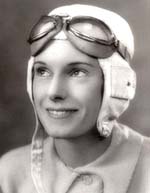 Jean Gardner Batten, CBE, (1909 -1982)
Jean Gardner Batten, CBE, (1909 -1982)Arguably New Zealand's greatest aviator was born Jane Gardner Batten on September 15, 1909 in Rotorua, New Zealand and despite her so to be made fame, died in obscurity on November 22, 1982 in Palma, Majorca. During the years 1933-37 she astounded the world time after time with feats of daring, combined with highly skilled flying prowess, setting and resetting solo distance/endurance records some to stand for many decades. This page gathers together information about Jean and her aircraft. Initially the reader should divert from this page to read two online essays that are pivotal in understanding this amazing woman. The second essay by Ian Mackersey is but a small taste of his book Jean Batten : The Garbo of the Skies, Warner Books,1999, 466pp, ISBN: 0 7515 3019 0 - essential reading for the Batten historian
http://www.auckland-airport.co.nz/batten3.html 1933
De Havilland Gipsy Moth Biplane G-AALG* (*Originally owned by The Prince of Wales 5 Sep 29 - 4 Feb 33) 1934
De Havilland Gipsy Moth Biplane G-AARB 1935
De Havilland Gipsy Moth G-AARB
Percival Gull Monoplane G-ADPR 1936
Percival Gull Monoplane G-ADPR Also first direct flight from England to Auckland. Also world record for fastest flight between Australia and New Zealand (101/2 hours). Established on same flight: England - Australia solo record, 10,500 miles in 5 days 21 hours total elapsed time. 1937
Percival Gull Monoplane G-ADPR
http://www.nzedge.com/heroes/batten.html New Zealand Speedsters - Jean Batten - Hine-o-te-Rangi (Daughter of the Skies) - She was the manifestation of triumph and hope through the dark days of the depression. In 1934 she smashed the world record between England and Australia by six days. In 1936 she made the first ever direct flight between England and New Zealand. Jean Batten stood for adventure, daring and exploration. ...more
Batten, Jean Gardner 1909-1982 Aviator One of the great international aviators of the 1930s, Jean Gardner Batten was born on 15 September 1909 in Rotorua, the only daughter of a dentist, Frederick Harold Batten, and his wife, Ellen (Nellie) Blackmore. She was christened Jane after her grandmother, but soon became known as Jean. ...more
1933 : England - India. De Havilland Gipsy Moth G-AALG 1934 : England - Australia (women's record) 10,500 miles in 14 days 22 hours 30 minutes
At right, Jean Batten at Croydon, England on April 29, 1935 after her solo flight from Australia to England
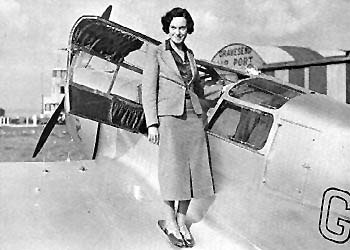
Jean Batten takes delivery of her new aircraft, a Percival Vega Gull at Gravesend Airport, September 1, 1935
1935 : England - Brazil: 5000 miles in 61 hours 15 minutes elapsed time. World record for any type of aeroplane. Also fastest crossing South Atlantic Ocean, 13 1/4 hours, and first woman to make England - South America flight. Percival Vega Gull Monoplane G-ADPR 1936 : England - New Zealand. World record for any type. 14,224 miles in 11 days 45 minutes total elapsed time, including 21/2 days in Sydney. Also first direct flight from England to Auckland. Also world record for fastest flight between Australia and New Zealand (101/2 hours). Established on same flight: England - Australia solo record, 10,500 miles in 5 days 21 hours total elapsed time. Percival Vega Gull Monoplane G-ADPR 1937 : Australia - England solo record, 5 days 18 hours 15 minutes. First person to hold both England - Australia and Australia - England solo records at the same time. Percival Vega Gull Monoplane G-ADPR.
Born in Rotorua, Jean had an early ambition to fly, and particularly to fly solo from England to New Zealand. In 1929 she went to England to join the London Aeroplane Club and gained private and commercial licences by 1932. She found sponsors and after two unsuccessful attempts to fly solo to Australia her persistence was repaid in 1934 when she cut Amy Johnson's solo record by four days. In 1935 Jean became the first woman to fly the south Atlantic from England to Brazil, establishing a new record speed for the flight. She had replaced her Gipsy Moth by a Percival Vega Gull monoplane and in this she flew from London to New Zealand, establishing a solo flight record which was maintained for 44 years, as well as a new solo England-Australia record and one for the fastest crossing of the Timor Sea. Before tackling this dangerous stretch she instructed the station commander: "If I go down in the sea no one must fly out to look for me...I have no wish to imperil the lives of others..." Her final record was for a flight from Australia to England in 1937, after which she kept up an active interest in aviation. She received many honours, including the Freedom of the City of London (1978) and Chevalier, Légion d'honneur.
http://www.nasm.edu/nasm/aero/women_aviators/jean_batten.htm Jean Batten grew up in New Zealand and developed a love for aviation than overcame her desire to be a concert pianist. Her interest in flying stemmed from the 1919 England to Australia flight by Ross and Keith Smith, and later solo flights, including Charles Kingsford Smith who gave Batten her first airplane ride. Batten's father did not approve of her aviation enthusiasm but she convinced her mother to move to England with her and help her become a pilot. She received her license and her commercial rating at the London Aeroplane Club at Stag Lane and then began planning for a flight from England to Australia. Her first two attempts failed, but she succeeded in 1934, flying a Gipsy Moth. Batten became an instant sensation in Australia, New Zealand and in England upon her return flight the next year (it was the first round trip by a woman). In 1935, she broke James Mollison's records for England to Brazil and Dakar to Natal while becoming the first woman to solo across the South Atlantic. Then, in 1936, she realized her dream of flying solo from England to New Zealand in a Percival Vega Gull in 11 days and earned her second consecutive Harmon Trophy, having shared the first one in 1935 with Amelia Earhart. In 1937 she set another record for an Australia to England flight. Unable to obtain a flying job during World War II, Batten gave up flying and eventually became a recluse, living with her mother in Majorca, Spain and appearing in public only for a few anniversary events. In 1937, she published her autobiography, My Life Copyright © 2000 National Air and Space Museum, Smithsonian Institution (information compiled by D. Cochrane and P. Ramirez 12/15/99)
http://www.auckland-airport.co.nz/batten.html Jean Batten was a pioneer aviator in the 1920s and 1930s when pilots proved to the world the potential of air travel as a means of transport. Jean Batten was born in Rotorua in 1909. Her interest in becoming a pilot was sparked when, in 1929, she met the Australian pilot, Charles Kingsford-Smith who took her for a flight in his famous plane, The Southern Cross. He had become a hero when he made the first trans-Pacific flight (1928) from America to Australia. When Jean travelled to London in 1930 with her mother, she joined an Aero Club which led to the fulfillment of her dream of becoming a pilot. Not satisfied with just gaining her Commercial Pilot's Licence, she was determined that she, too, would make a solo flight to Australia. Her first attempt in a second-hand Gipsy Moth ended when she crashed in Karachi. A second attempt, also in a Gipsy Moth, failed when she made a forced landing after running out of fuel near Rome. Instant fame came to her when her third attempt, in May 1934, was not only successful but also smashed Amy Johnson's England-Australia record. However, her finest hour was to come on 16 October, 1936 when she arrived at Auckland where she was welcomed by a crowd of 6,000 people who had flocked to the small grass air strip at Mangere to greet her at the end of what was the first flight from England to New Zealand. Her 14,224 mile journey from England took 11 days and 45 minutes, a time which was to remain a solo record for 44 years. The Percival Vega Gull G-ADPR in which she made the journey now hangs in the Jean Batten International Terminal. This little monoplane enabled her to establish herself as one of the great women aviators of all time. Her flights were characterised by brilliant navigation precision, achieved without radio, using only a map, watch and simple magnetic compass. She flew the Vega Gull from England to Brazil in 1935 in 61 hours 15 minutes; from England to Australia in five days 21 hours (en route to New Zealand in 1936); and in the spectacular solo record time of five days 18 hours 15 minutes from Australia back to England in 1937. During the Second World War, Jean Batten was involved in campaigns in England to raise money for guns and aeroplanes. Her Percival Vega Gull was commissioned to active service but Jean never flew again. After the War, she and her mother lived together in various locations around the world, although never in New Zealand, until Mrs. Batten's death in 1965 at the age of eighty nine. Jean, herself died alone in Majorca on 22 November, 1982 where, unknown, she was buried in a communal paupers' grave with the world unaware of her fate for a further five years. In her will, Jean Batten requested that her body be taken to London for cremation and her ashes carried to Auckland to be interred at Auckland International Airport. Due to the nature of her burial in Palma this was not possible, but her memory remains alive in the Jean Batten International Terminal.
http://www.humanbeams.com/slices/batten.shtml Today, with the entire world at our fingertips, it's difficult to imagine that there was a time when long-distance air travel was a heroic deed. But back in the thirties, the pioneer aviators flew at low altitudes in the midst of adverse weather, alone, without radio, relying only on the most rudimentary equipment. Some of the pioneers were women Jean Batten was born in Rotorua, New Zealand, in 1909, the daughter of an impoverished dentist and a dominating mother. She met renowned pilot Kingsford-Smith on a visit to Australia in 1929 and took a ride in his plane. It was then that Jean decided to become a pilot. She travelled to London, joined an aero club, and in 1930 at the age of 21 she made her first solo flight for her private pilot licence. At twenty, Jean was a bit of a slow learner. Her colleagues described her as "far from being a natural pilot". One of them recalled the day she crashed: flying solo, she had overshot on landing, hit a wire fence and overturned. Although she emerged physically unscathed, her confidence was shaken. She doubted that she would ever be any good at flying. Yet she persisted, urged on by the prominence of Amy Johnson's historic flight from England to Australia in just 19.5 days. Jean obtained her commercial licence in 1932, and immediately made two attempts to fly to Australia. In the first, the engine of her Gipsy Moth stopped, and she was forced to land short of Karachi Airfield in India. A year later, in another second-hand Gipsy Moth, she ran out of fuel, and had to land near Rome. But Jean was no quitter. In May 1934, her day came. She knocked four days off Amy Johnson's 1930 record, by flying alone in a tiny aircraft made of wood and fabric, from England to Australia, in just under fifteen days. To top it, she flew back. Later, she piloted a small cabin plane across the South Atlantic; and became the first person ever to fly solo from England to New Zealand. Her record (covering 14,224 miles in 11 days and 45 minutes) stood for 44 years. Her flights became legendary in the years of the Depression, when people craved escapism. Long-distance solo record flying became an epidemic. The public would literally cause traffic jams to see the flying celebrities touch down in their moment of glory. But in the late thirties, with the war looming, solo aviation records lost their appeal. Jean Batten hung up her flying helmet and went into fiercely guarded seclusion. She resurfaced briefly in the sixties, when she offered herself for media interviews. But by then, most people didn't know her name. The Garbo of the skies had achieved obscurity. In 1982 she went to Majorca to look for a new home. That was the last time anybody heard from her. In fact, Jean had died in Palma just five weeks after arriving on the island. But it took five years for that fact to be unearthed. Her death certificate gives no indication of the cause of death. Nobody knows where she is buried. (these last two facts are incorrect; she died of a pulmonary abscess the end result of an improperly tended dogbite and is buried in a known 'pauper's' grave in Palma. Ed. 07/2001 ref. Mackersey) copyright ©1999 Yvonne Eve Walus
Jean Batten's Aircraft : DH-60 Gipsy Moth and Percival Vega Gull 6 1933-34 DH-60 Gipsy Moths similar to Jean's G-AALG of1933 and G-AARB of 1934
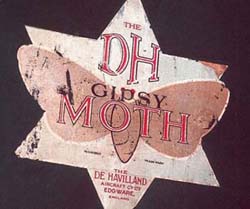 De Havilland DH-60 Gipsy Moth Insignia In fact from Amy Johnson's de Havilland Gipsy Moth, 'Jason' Photo : Science Museum, London
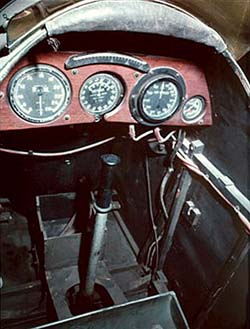 De Havilland DH-60 Gipsy Moth Cockpit In fact the cockpit of Amy Johnson's de Havilland DH-60 Gipsy Moth, 'Jason' Photo : Science Museum, London
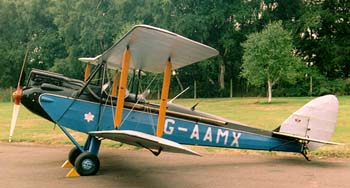 De Havilland DH-60 Gipsy Moth, G-AAMX Photo : TBA you may also wish to download a 750 pixel image
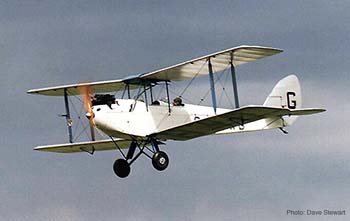 De Havilland DH-60 Gipsy Moth, G-**** Photo: © Dave Stewart you may also wish to download a 750 pixel image
 De Havilland DH-60 Gipsy Moth, G-**AG Photo: © Dave Stewart you may also wish to download a 750 pixel image
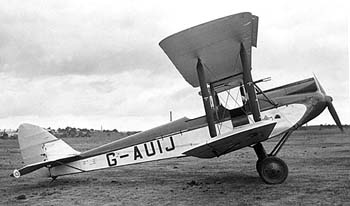 De Havilland DH-60 Gipsy Moth, G-IUAJ Photo : TBA you may also wish to download a 750 pixel image
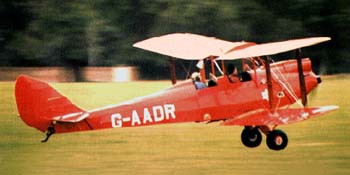 De Havilland DH-60 Gipsy Moth, G-AADR Photo : TBA
Back to Essay 1935, 36 and 1937 Percival Vega Gull 6 : G-ADPR
The first Percival Vega Gull, built in 1932, was considered highly advanced when it first appeared. Its sleek looks contrasted with the biplanes typical of the period.
The monoplane was constructed of wood and fabric and has a wingspan of 11.02 metres and a length of 7.6 metres. It made many record breaking flights until war broke out in 1939 when it was requisitioned by the Royal Air Force as a communication aircraft bearing the designation AX866. Percival Aircraft, designers and manufacturers of the Vega Gull, (later to become the Hunting Group) bought the plane in 1946 at the end of the war. The Company used it only intermittently, so in April 1961 the Group presented it to the Shuttleworth Trust to join their collection of historical aircraft.
 Jean Batten's Percival Vega Gull G-ADPR, on display at Auckland International Airport. http://tinpan.fortunecity.com/blur/862/aucklandsep99/
The Vega Gull was flown occasionally on public display days until it required major restoration. This was sponsored by the Hunting Group in association with the Shuttleworth Trust and began in 1987. It was a massive task to make this historic aircraft completely airworthy again. Auckland International Airport Limited borrowed the plane to be displayed in The International Terminal during 1990 for New Zealand's 150th anniversary celebrations which coincided with the 25th anniversary of the opening of Auckland International Airport. After its return to England, the Airport Company negotiated to purchase the Percival Vega Gull G-ADPR. The last time it flew was over Auckland in 1996 to mark the sixtieth anniversary of Jean Batten's record breaking flight between England and Auckland.
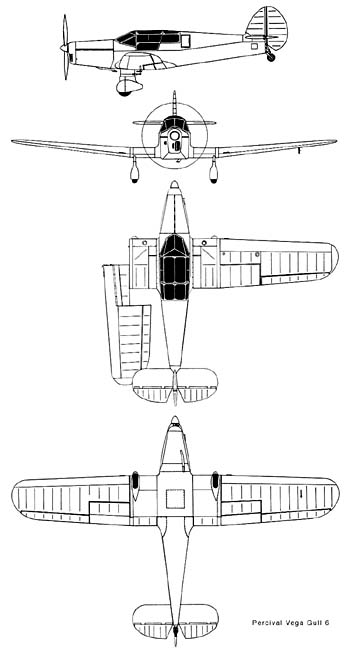 Percival Vega Gull - 4view
Commemoration Flight Goes Awry http://nz.com/NZ/News/WYSIWYG/1996_News/1996November10.html Jean Batten's lovely little Percival Mew Gull was recently acquired by the Auckland International Airport company. Last Sunday (Nov. 4, 1996; Ed.) , it was scheduled to fly over the Auckland region to mark the sixtieth anniversary of Jean Batten's epic solo flight from England to New Zealand. The aircraft took off with Cherie Marshall at the controls, but while over the Auckland harbour, the engine started to run roughly. Ms Marshall put in a Mayday call and headed back to Mangere, where to everyone's immense relief, a safe landing was made. The aircraft will now go on permanent display, and in all probability, will never fly again.
The Vega Gull is a four seater cabin monoplane of the familiar Percival low-wing type, constructed of wood and fabric. Good stream-lining and a 200 h.p. Gipsy Six engine give it a cruising speed of 170 m.p.h. and a range of 660 miles. Dual controls are provided for the two front seats, the pilot normally sitting on the port side, as is usual with the larger types of aircraft.
Aircraft of the Fleet Air Arm Archive 1939-1945
Mrs Beryl Markham (card 21) pilot of a Percival Gull. [...] Beryl was the first woman to make the East-to-West N.Atlantic Crossing and also hold the record for the fastest East-West N.Atlantic crossing. The Percival Gull was obviously something to be seen flying about in. Harry Frank Broadbent (Australian) is seen in one. In 1935 he beats C.J. Melrose record for a solo flight around Australia and in the same year flew from Australia to England. It was also the aircraft of choice for Miss Jean Batten (card 43). While it seems everyone wanted to get from Australia to England she was keen as mustard to do it the other way around. It was third time lucky for her, the previous attempts ending in India and Italy. Mrs Harry Bonny [Lores Bonney, Ed.] (isn't that annoying, I'd have liked the card to at least tell us what her mother used to call her when it was time for dinner. Perhaps it was Harry but I doubt it) was an Australian airwoman. Australians were pretty keen pilots as lets face it half of them needed airstrips in the back garden if they wanted to visit the neighbours for coffee. The card shows her plane [Lores Bonney's Percival Gull?] as being a pretty lurid pink, very Penelope Pitstop. The card notes her principal acheivement as being a solo flight from Australia to England.
Her spectacular flights ranked with those of Britain's Amy Johnson and American's Amelia Earhart. Yet, despite her brilliance as a pilot, she remained the least well-known of them all. For the dentist's daughter from New Zealand built an impregnable wall around her private life - which was dominated, though few ever knew it, by the formidable influence of her mother.
The real Jean Batten emerges as a fascinating woman, who combined bravery and ruthlessness with the stunning and seductive beauty she used so effectively to fulfil her great ambitions. ''A fascinating book ... superbly researched'' Mary S. Lovell, author of Straight On Till Morning "I find it impossible to over-praise a story which reads like a superior detective novel while bringing a totally new depth of understanding to this extraordinary woman'' Daily Mail ''Ian Mackersey's tireless digging has done Jean, her family and aviation a great service." Guardian also...
Transcript Engines of our Ingenuity : No. 1503: New Women Fliers
Transcript Jean Batten : www.i5ive.com Hard for the modern New Zealand woman to imagine not being able to pursue her dream, but in the early decades of the last century it took determination and strength to do so. Only these types of individuals were able to break out of the mould and achieve things that would forever mark them apart. One of those was the aviatrix Jean Gardner Batten. An enigma who single mindedly, and sometimes in ways that others did not approve of, set out to get her place in the history books. Her end may not have been heroic, but remained true to her nature.
Part Oneother On Line
Jean Batten
Wings around the World Solo Challenge
youngeagles.org : Jean Batten
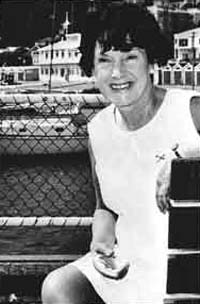 Jean Batten in Wellington, New Zealand, Jan., 1970. The Evening Post, Wellington, New Zealand http://www.nzedge.com/heroes/batten.html
|
© Copyright 1999-2002 CTIE - All Rights Reserved - Caution |
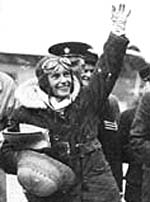 1935 : Australia - England in 17 days 15 hours. First woman to make return flight. De Havilland Gipsy Moth G-AARB
1935 : Australia - England in 17 days 15 hours. First woman to make return flight. De Havilland Gipsy Moth G-AARB Jean Batten's Percival Vega Gull G-ADPR
Jean Batten's Percival Vega Gull G-ADPR Mackersey, Ian, Jean Batten : The Garbo of the Skies, Warner Books,1999, 466pp, ISBN: 0 7515 3019 0
Jean Batten was one of the great aviation megastars of the 193Os.
Mackersey, Ian, Jean Batten : The Garbo of the Skies, Warner Books,1999, 466pp, ISBN: 0 7515 3019 0
Jean Batten was one of the great aviation megastars of the 193Os.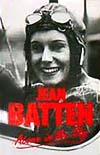 Batten, Jean, Alone In The Sky. illus. with 12 full page plates t/out. pub. N.Z. Technical books 1979 1st.ed. or.cl. d/w. 8vo. pp.190. signed by Jean Batten.
Batten, Jean, Alone In The Sky. illus. with 12 full page plates t/out. pub. N.Z. Technical books 1979 1st.ed. or.cl. d/w. 8vo. pp.190. signed by Jean Batten.